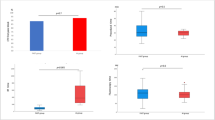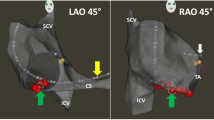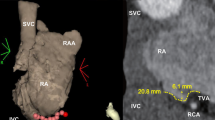Abstract
Purpose
Cavotricuspid isthmus (CTI) ablation for typical atrial flutter (AFL) has become the preferred treatment for this arrhythmia. The aims of this study were to assess the impact of respiratory gating (RG) on electroanatomical mapping of CTI and to assess the efficiency of CTI ablation guided by the Carto3® system equipped with the new respiration gating software.
Methods
Forty-four consecutive patients (mean age, 60 ± 13 years; 25 male) undergoing cavotricuspid ablation for symptomatic common AFL were randomly assigned to CARTO™ mapping with or without enabling RG module (Group A, RG OFF, Group B, RG ON).
Results
A significant reduction in mean RA volume, CTI central length and CS ostium maximum diameter has been observed in the RG maps. The mean total procedural, fluoroscopy and radiofrequency (RF) time were 102.9 ± 35.3, 10.6 ± 3.3, 22.9 ± 14.2 min in group A and 75.3 ± 21.7, 3.6 ± 4.5, 10.4 ± 5.7 min in group B, respectively (p < 0.05).
Conclusions
Electroanatomical mapping systems’ accuracy may be strongly influenced by respiration movements. The current study showed that automatic respiratory gated acquisition resulted in a better visualization of CTI, and this determines a relevant reduction in fluoroscopy and RF times.




Similar content being viewed by others
Abbreviations
- CTI:
-
Cavotricuspid isthmus
- AFL:
-
Atrial flutter
- EAM:
-
Electroanatomical mapping/map
- FAM:
-
Fast anatomical mapping
- RA:
-
Right atrium
- LA–PV:
-
Left atrium–pulmonary vein
- RG:
-
Respiratory gating
- CS:
-
Coronary sinus
- RTG:
-
Real-time graph
- RF:
-
Radiofrequency
References
Poty, H., Saoudi, N., Nair, M., Anselme, F., & Letac, B. (1996). Radiofrequency catheter ablation of atrial flutter. Further insights into various types of isthmus block: application to ablation during sinus rhythm. Circulation, 94(12), 3204–3213.
Cauchemez, B., Haissaguerre, M., Fischer, B., Thomas, O., Clementy, J., & Coumel, P. (1996). Electrophysiological effects of catheter ablation on inferior vena cava-tricuspid annulus isthmus in common atrial flutter. Circulation, 93(2), 284–294.
Schwartzman, D., Callans, D. J., Gottlieb, C. D., Dillon, S. M., Movsowitz, C., & Marchlinski, F. E. (1996). Conduction block in the inferior vena cava-tricuspid valve isthmus: association with outcome of radiofrequency ablation of type I atrial flutter. Journal of the American College of Cardiology, 28(6), 1519–1531.
Houmsse, M., & Daoud, E. G. (2012). Radiation exposure: a silent complication of catheter ablation procedures. Heart Rhythm, 9(5), 715–716.
Beinart, R., Kabra, R., Heist, K. E., Blendea, D., Barret, C. D., Danik, S. B., et al. (2011). Respiratory compensation improves the accuracy of electroanatomical maping of the left atrium and pulmonary veins during atrial fibrillation. Journal of Interventional Cardiac Electrophysiology, 32(2), 105–110.
Noseworthy, P. A., Malchano, Z. J., Ahmed, J., Holmvang, G., Ruskin, J. N., & Reddy, V. Y. (2005). The impact of respiration on left atrial and pulmonary venous anatomy: implications for image-guided intervention. Heart Rhythm, 2(11), 1173–1178.
Stabile, G., Scaglione, M., del Greco, M., De Ponti, R., Bongiorni, M. G., Zoppo, F., et al. (2012). Reduced fluoroscopy exposure during ablation of atrial fibrillation using a novel electroanatomical navigation system: a multicentre experience. Europace, 14(1), 60–65.
Scaglione, M., Biasco, L., Caponi, D., Anselmino, M., Negro, A., Di Donna, P., et al. (2011). Visualization of multiple catheters with electroanatomical lapin reduces X-ray exposure during atrial fibrillation ablation. Europace, 13(7), 955–962.
Cabrera, J. A., Ho, S. Y., & Sanchez-Quintana, D. (2009). How anatomy can guide ablation of isthmic atrial flutter. Europace, 11(1), 4–6.
Kottkamp, H., Hugl, B., Krauss, B., Wetzel, U., Fleck, A., Schuler, G., et al. (2000). Electromagnetic versus fluoroscopic mapping of the inferior isthmus for ablation of typical atrial flutter. A prospective randomized study. Circulation, 102(17), 2082–2086.
Alvarez, M., Tercedor, L., Herrera, N., Munoz, L., Galdeano, R. S., Valverde, F., et al. (2011). Cavotricuspid isthmus ablation without the use of fluoroscopy as a first-line treatment. Journal of Cardiovascular Electrophysiology, 22(6), 656–662.
Ector, J., de Buck, S., Loeckx, D., Coudyzer, W., Maes, F., Dymarkowski, S., et al. (2008). Changes in left atrial anatomy due to respiration: impact on three-dimensional image integration during atrial fibrillation ablation. Journal of Cardiovascular Electrophysiology, 19(8), 828–834.
Feld, G. K., Flech, R. P., Chen, P. S., Boyce, K., Bahnson, T. D., Stein, J. B., et al. (1992). Radiofrequency catheter ablation for the treatment of human type 1 atrial flutter: identification of a critical zone in the reentrant circuit by endocardial mapping techniques. Circulation, 86(4), 1233–1240.
Cosio, F., Lopez Gil, M., Goicolea, A., Arribas, F., & Barroso, J. L. (1993). Radiofrequency ablation of the inferior vena cava-tricuspid valve isthmus in common atrial flutter. The American Journal of Cardiology, 71(8), 705–709.
Gami, A. S., Edwards, W. D., Lachman, N., Friedman, P. A., Talreja, D., Munger, T. M., et al. (2010). Electrophysiological anatomy of typical atrial flutter: the posterior boundary and causes for difficulty with ablation. Journal of Cardiovascular Electrophysiology, 21(2), 144–149.
Tai, C. T., & Chen, S. A. (2009). Cavotricuspid isthmus: anatomy, electrophysiology, and long-term outcome of radiofrequency ablation. Pacing and Clinical Electrophysiology, 32(12), 1591–1595.
Kirchhof, P., Ozgun, M., Zellerhoff, S., Monning, G., Eckardt, L., Wasmer, K., et al. (2009). Diastolic isthmus length and vertical isthmus angulation identify patients with difficult catheter ablation of typical atrial flutter: a pre-procedural MRI study. Europace, 11(1), 42–47.
Hindrincks, G., Willems, S., Kaurtzner, J., de Chillou, C., Weidemann, M., Schepel, S., et al. (2009). Effect of electroanatomically guided versus conventional catheter ablation of typical atrial flutter on the fluoroscopy time and resource use: a prospective randomized multicenter study. Journal of Cardiovascular Electrophysiology, 20(7), 734–740.
Anselme, F., Savoure, A., Cribier, A., & Saoudi, N. (2001). Catheter ablation of typical atrial flutter. A randomized comparison of 2 methods for determining complete bidirectional block. Circulation, 103(10), 1434–1439.
Vollmann, D., Luthje, L., Seegers, J., Hasenfuss, G., & Zabel, M. (2009). Remote magnetic catheter navigation for cavotricuspid isthmus ablation in patients with common-type atrial flutter. Circulation: Arrhythmia and Electrophysiology, 2(6), 603–610.
Ilg, K. J., Kuhne, M., Crawford, T., Chugh, A., Jongnarangsin, K., Good, E., et al. (2011). Randomized comparison of cavotricuspid isthmus ablation for atrial flutter using an open irrigation-tip versus a large-tip radiofrequency ablation catheter. Journal of Cardiovascular Electrophysiology, 22(9), 1007–1012.
Belhassen, B., Glick, A., Rosso, R., Michowitz, Y., & Viskin, S. (2011). Atrioventricular block during radiofrequency catheter ablation of atrial flutter: incidence, mechanism, and clinical implications. Europace, 13(7), 1009–1014.
Sassone, B., Leone, O., Martinelli, G. N., & Di Pasquale, G. (2004). Acute myocardial infarction after radiofrequency catheter ablation of typical atrial flutter: histopathological findings and etiopathogenetic hypothesis. Italian Heart Journal, 5(5), 403–407.
Mykytsey, A., Kehoe, R., Bharai, S., Maheshwari, P., Halleran, S., Kousik, K., et al. (2010). Right coronary occlusion during RF ablation of typical atrial flutter. Journal of Cardiovascular Electrophysiology, 21(7), 818–821.
Conflict of interest
Ermenegildo de Ruvo received consulting honoraria from Biosense Webster, Inc.; Serena Dottori is an employee of Biosense Webster Inc. No financial or other relations that could lead to a conflict of interest is present for other authors.
Author information
Authors and Affiliations
Corresponding author
Additional information
Editorial Commentary
In a randomized study De Ruvo et al. evaluated the impact of respiratory gating on electroanatomical mapping of the cavo-tricuspid isthmus (CTI) region during catheter ablation of typical atrial flutter. The authors showed a reduction of CTI central length and right atrial volume. Furthermore a reduction of fluoroscopy and radiofrequency times was also reported. Whether such benefits translate in better long-term freedom from recurrent arrhythmia is unclear.
Rights and permissions
About this article
Cite this article
de Ruvo, E., Dottori, S., Sciarra, L. et al. Impact of respiration on electroanatomical mapping of the right atrium: implication for cavotricuspid isthmus ablation. J Interv Card Electrophysiol 36, 33–40 (2013). https://doi.org/10.1007/s10840-012-9745-7
Received:
Accepted:
Published:
Issue Date:
DOI: https://doi.org/10.1007/s10840-012-9745-7




